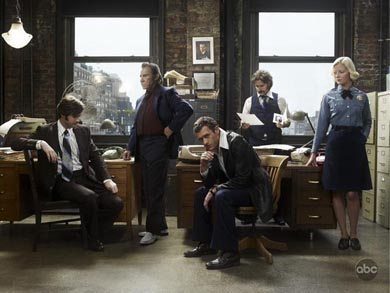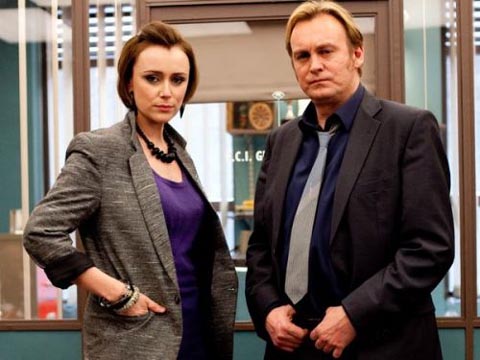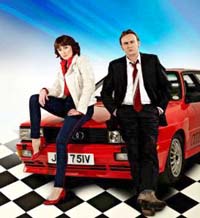The American version of Life on Mars débuted in the United States last night and while we are still waiting for rating figures at the moment, it looks like it will be a hit. However, it will be for different reasons, despite a script for the première episode that is remarkably close to the original.
The adapters, Josh Appelbaum, André Nemec and Scott Rosenberg, who also produce the series, have recognized which elements of the successful BBC version to keep: the social commentary, the humour, and the dark, muted tones of the original set in Manchester.
While a few scenes are changed, one in particular trumps the British original: Sam Tyler (played by Irish actor Jason O’Mara), arriving in 1973, sees the World Trade Center looming overhead. Given 9-11’s significance in our lives, the scene is far more poignant in a TV show than the original where Sam Tyler, John Simm, sees a billboard for an unbuilt Manchester motorway.
Overall, most will agree that the original was hard to beat, though the Americans have done a fabulous job in the remake.
Earlier in 2008, a Los Angeles-set version, produced and adapted by David E. Kelley of Boston Legal, was leaked on to the internet and was strongly criticized—showing just how poorly an adaptation could go.
For a while it seemed all the doubters—mostly Britons on their high horse dismissing all American remake attempts (conveniently forgetting the UK’s own record with Who’s the Boss?, Married with Children, Outrageous Fortune and potentially the upcoming Law & Order and Bewitched) were right. But the network, ABC, realized things could be better—exit Kelley, enter the new producers. The shiny, 21st-century colours of the Los Angeles pilot were dumped; the dark, New York feel came in.
It was a good move, not just because New York was offering tax credits to producers ?lming there, but because the dreary setting of a city facing bankruptcy is not that far from the mood of 2008.
When times are tough, people generally wish to look back at the past with rose-coloured glasses.
And as predicted earlier this week, Life on Mars did not so much remind us of what 1973 was like, but re-created some of the uncertainty we feel in the present day. In that respect, it differed from the original, which contrasted 1973 and 2006.
Meanwhile, it gave enough levity and escapism to viewers, even if the Americans do not quite have the same regard for Kojak as the British do for The Sweeney.
We had said at Lucire that fashion looks very 1970s right now, anyway. Not necessarily on the catwalks, but in what people choose to wear. Those in search of correlations between fashion and economic climate—any observer of fashion will have come across some anecdotal evidence of hemlines and the stock market index—might see parallels again.
New York, in 1973, was nearly bankrupt and the mood was sour as the Vietnam War faltered.
The pessimism of 2008 is now largely financial in origin, not that things were exactly cheerful as the public support for the War on Terror diminished. The latter could have been foreseen by the network and the producers, but could the former?
It is easy to point out now how some post-9-11 cinema and TV have a gritty, early 1970s feel reminiscent of The French Connection—the Jason Bourne trilogy with Matt Damon is an example. However, Life on Mars may be the one of the few notable times that the period has been put so squarely in front of us in a retro TV series. (There was the poorly promoted Journeyman last year, but the time travel was sporadic and the hero always returned to 2007.)
That ’70s Show, the mid-1990s sitcom, probably reflected a Clinton-era optimism by laughing at the styles; the various Brady Bunch movies had a similar function. One doubts if either would match the demands of the 21st century audience as well.
Assuming the best for the new series—that it defies the pessimists by surviving beyond the 16 episodes of the BBC series, and goes on to last a few seasons—Life on Mars may well chart the switch from our present pessimism to a more optimistic time, as it goes from the downbeat mood of 1973 toward the Bicentennial. As it does that, it might be a fairly accurate barometer of our fashion, too.
From Marisa Miller and Harleys, to James Bond and Astons
New York, photographed by Douglas Rimington
US Life on Mars successfully charts the mood of our times
Categories
culture / entertainment / fashion / film / history / Los Angeles / Lucire / media / New York / society / tendances / trend / TV / Zeitgeist
Filed by Jack Yan
culture / entertainment / fashion / film / history / Los Angeles / Lucire / media / New York / society / tendances / trend / TV / Zeitgeist
Filed by Jack Yan








Living in NYC for the past few years, I am a sucker for NY shows and movies. I feel like i am missing something for living in the “Bloomberg-ified” NY and while every movie about ’73 NY screams gritty (for false like American Gangster for example), Life on Mars feels different.
it doesn’t feel like the French Connection, but on the other hand, it doesn’t feel like the best memories of a time gone by. I hope that its attention to detail and strong writing allow it to carve out a vision of its own.
Well said, Sean. I hope so, too. There is excellent source material (the original 16 scripts) and provided they can stay authentic (e.g. the set designers seem to have had a lot to work with) I think it will carve out that unique vision as you said.